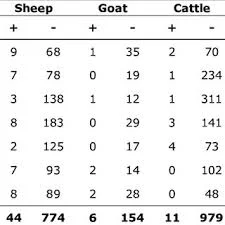Definition:Livestock Body Condition Scoring (BCS) is a non-invasive technique used to assess the relative fat reserves or energy stores of an animal. It's a valuable tool for farmers and ranchers to monitor animal health, make informed feeding decisions, and optimize production.
Click the Translate button(see right) on this post to set your Own Language to understand more perfectly!!
Livestock Body Condition Scoring Calculator
Continue Definition:
Livestock Body Condition Scoring (BCS)
Livestock Body Condition Scoring (BCS) is a non-invasive technique used to assess the relative fat reserves or energy stores of an animal. It's a valuable tool for farmers and ranchers to monitor animal health, make informed feeding decisions, and optimize production.
Important Points:
Species Specific: There's no single BCS system applicable to all livestock. Each species (e.g., cattle, sheep, horses) has its own scoring system with specific guidelines for evaluation.
Visual and Tactile: BCS relies on a combination of visual appraisal and feeling key body parts to assess fat deposition over muscle and bone.
Numerical Scale: A scoring system typically uses a numerical scale (e.g., 1-9 or 1-5) with higher scores indicating greater fat reserves and lower scores indicating thinner animals.
Factors Considered in BCS:
Visual Appraisal: General body shape, prominence of bones (ribs, spine, hips), muscle wasting, and fat deposits over specific areas (tailhead, shoulder) are visually assessed.
Tactile Evaluation: By feeling certain body areas (ribs, backbone, loin) with the hands, the examiner can assess fat cover over these skeletal structures.
Sample Values (using Beef Cattle as an example):
Body Area Very Thin (Score 1) Moderately Thin (Score 3) Moderately Fleshy (Score 5) Fat (Score 7)
Ribs Extremely prominent, easily counted Individually identifiable, minimal fat cover Smoothly rounded, difficult to feel Not palpable under moderate pressure
Backbone Sharp and prominent Edges can be felt with slight pressure Rounded and smooth, but backbone detectable Not discernible under firm pressure
Tailhead Minimal fat deposition, bony prominence evident Slight fat cover, bony processes detectable Well-rounded, tailhead blends smoothly Excessive fat deposition, tailhead obscured
Example Calculation (Beef Cattle):
A veterinarian examines a cow and observes:
Ribs are slightly visible but not individually countable (indicating score between 2 and 3).
Backbone edges are detectable with moderate pressure (indicating score around 4).
Tailhead is smoothly rounded with minimal fat excess (indicating score close to 5).
Based on these observations, the veterinarian assigns a BCS of 3.5 to the cow. This score suggests the cow is on the thinner side and might benefit from increased feed intake or a change in diet to improve body condition.
Additional Suggestions:
It's crucial to consult species-specific BCS guidelines and diagrams for accurate scoring.
Regularly calibrating your scoring technique with experienced professionals ensures consistency and reliable results.
BCS is most effective when used alongside other animal health assessments.
By implementing BCS, farmers can promote optimal animal health, improve reproductive performance, and ensure efficient livestock production.
How is it possible to earn money using the knowledge of Livestock Body condition Scoring Calculation?????
You can't directly earn money by just calculating a Livestock Body Condition Score (BCS). However, your knowledge of BCS can be valuable in several ways that can indirectly lead to financial gain:
1. Consulting Services:
Livestock Consultant: Offer your expertise as a consultant to farmers and ranchers. You can: Conduct on-site BCS evaluations of their herds.
Analyze results and provide recommendations for adjusting feeding programs or management practices to improve animal health and productivity.
Develop customized BCS training programs for farm staff.
Data Analysis for Feed Companies: Partner with feed companies to analyze data collected from farms implementing BCS programs. You can help them:
Identify trends in animal health and performance based on BCS data.
Develop targeted feeding recommendations based on BCS scores.
2. Improved Farm Management:
Increased Efficiency: By using BCS to monitor your own livestock, you can:
Optimize feed costs by ensuring animals receive the right amount of nutrients based on their body condition.
Reduce health problems associated with under or over-conditioning.
Improve reproductive performance in breeding animals.
Ultimately, increase profitability by maximizing animal production and minimizing expenses.
3. Educational Roles:
Workshops and Trainings: Share your knowledge by conducting workshops or training sessions for farmers and ranchers on the importance of BCS and its practical application.
Content Creation: Develop educational materials (written guides, videos) on BCS for online platforms or agricultural publications.
4. Integration with Technology:
Develop Apps/Software: Combine your BCS knowledge with technology to create mobile apps or software tools that help farmers:
Easily record and track BCS data for individual animals.
Receive automated recommendations based on BCS scores.
Analyze trends and make informed management decisions.
Additional Tips:
Certification: Consider obtaining a certification in livestock nutrition or animal science to enhance your credibility as a consultant.
Networking: Build relationships with farmers, ranchers, veterinarians, and agricultural companies to increase your visibility and potential for collaboration.
By leveraging your knowledge of BCS and taking a proactive approach, you can create valuable services or tools that generate income while positively impacting the livestock industry.
Do YOU Want To Earn Money In Various Ways, Click The Link & Explore Your Field of Interest!!!







No comments:
Post a Comment